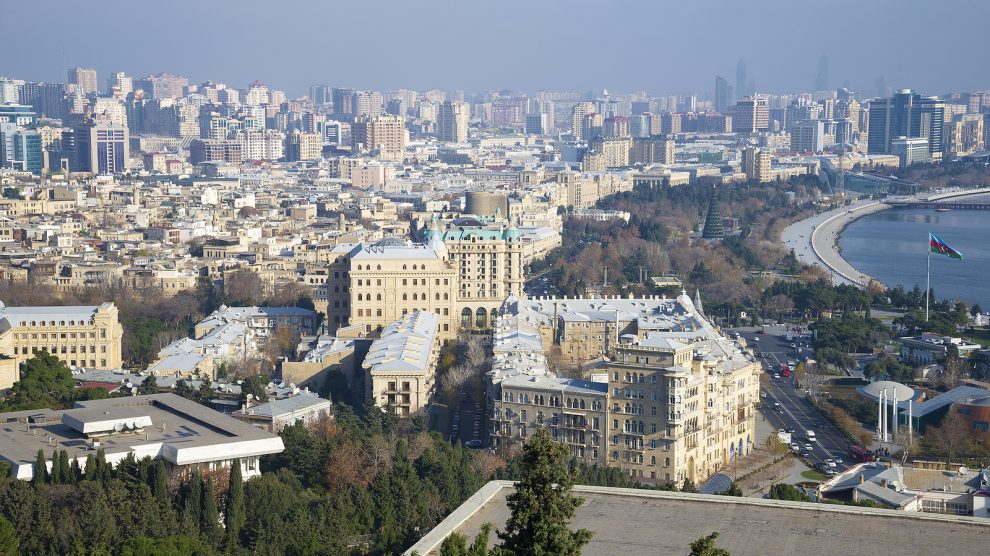Azerbaijan needs to diversify its economy away from fossil fuels. One of the ways this can be achieved is by investing in human capital in rural areas.
A transit hub since Silk Road times, Azerbaijan’s strategic location on the Caspian Sea between Russia, Iran, Armenia, and Georgia rewarded it with easy trade access to China, Central Asia, and Europe even before the discovery of its vast fossil fuel reserves.
Marco Polo wrote that oil from the Absheron peninsula was burned for heat and exported to the Middle East, and the world’s first industrial exaction of oil from a drilled well took place in Azerbaijan in 1846.
Since Azerbaijan gained independence in 1991, its industry and population have further concentrated into the Absheron peninsula’s Greater Baku Area, comprised of Baku, Sumqayit, and satellite cities, which has immediate proximity to the Caspian Sea’s offshore oil and gas reserves.
Those oilfields produce 90 per cent of the country’s exports and almost two-thirds of total budget revenue.
After the First Karabakh War, which ended in 1994, fossil fuel exports boomed, sustaining growth at 11 per cent from 2000 to 2015, before experiencing a slowdown. Since then, Azerbaijan has attempted—without much success—to diversify its economy away from fossil fuels.
“Global transition towards a low-emissions economic model offers opportunities for Azerbaijan to be globally and regionally competitive,” said Sarah Michael, World Bank Country Manager for Azerbaijan. “To make the best of it, Azerbaijan needs to focus on decarbonising and diversifying the economy, bolstering innovation, and natural and human capital development.”
Inequality and rural poverty
Poverty declined from 49 per cent in 2004 to 4.9 per cent in 2014, but inequality remained—according to a 2021 World Bank report, Azerbaijan exhibits more than two times the inequality of any other country in Europe and Central Asia with poverty concentrated in rural areas.
While over 40 per cent of the population works in agriculture, the sector accounts for only 5.7 per cent of gross domestic product due to undeveloped agro-processing industries, limited access to finance, poor market linkages, and lack of skills and knowledge on modern agricultural technologies.
The departure of educated and skilled workers from rural areas for Baku or other countries further worsens human capital gaps between urban and rural populations. Over a million Azerbaijanis have emigrated to Russia, Turkey, the European Union, Ukraine, Israel, Central Asia, and elsewhere for education and work.
“If the active and dynamic part of the population from the regions flows to the capital, the development of the regions weakens significantly,” suggested economist Rovshan Aghayev for the Baku Research Institute. “That is because the depopulation of rural regions is not related to the production, migrants are also consumers, and as internal migration expands, regions lose their advantages as markets.”
Outlook
Growth slowed in 2022 as inflation soared to 13.9 per cent for the year and oil production slowed. Inflation remained as high as ten per cent in September 2023, and the Asian Development Bank forecasts Azerbaijan will have the lowest growth rate in gross domestic product (GDP)—only 2.2 per cent—of any country in Central Asia and the Caucasus.
Higher household income boosted private consumption by 5.1 per cent in the first half of 2023 but continued double-digit inflation may curb real incomes and consumption.
Although the war in Ukraine has increased Western interest in Azerbaijan as a source of energy and as a key link in the Middle Corridor to circumvent Russia, there are still serious logistics and capacity concerns to address before that route will be ready to handle the same volume of trade as Russia’s trans-Siberian networks.
Since Azerbaijan regained control over areas of Nagorno-Karabakh and its surroundings in the Second Karabakh War in 2020, there have been extensive efforts to rebuild areas damaged by the conflict ahead of the return of hundreds of thousands of internally displaced Azerbaijanis. High government investment—including in pipelines, hydropower plants, and the restoration of historical structures in Karabakh—boosted growth in construction from 8.7 per cent in the first seven months of 2022 to 13.2 per cent a year later.
Baku’s September offensive against the remaining areas of Karabakh under the control of the Artsakh breakaway state resulted in the tragic exodus of almost all of the region’s 120,000 ethnic Armenian residents but also put an end to a conflict that has been a source of geopolitical instability for three and a half decades. All of the territory de jure recognised as Azerbaijan has returned to Baku’s de facto control.
However, a war with Armenia-proper to seize a land corridor connecting mainland Azerbaijan with its exclave of Nakhchivan would jeopardise this newfound political certainty and risk Western sanctions.
Prioritising diversification and tourism, investing in human capital in rural areas, re-opening its land borders (closed since the Covid-19 pandemic), ensuring a meaningful improvement in the quality of life of its internally displaced persons, and finalising a long-sought peace agreement with Armenia would allow Azerbaijan to remedy its structural challenges while guaranteeing peace and cooperation for future generations of Caucasians.
Unlike many news and information platforms, Emerging Europe is free to read, and always will be. There is no paywall here. We are independent, not affiliated with nor representing any political party or business organisation. We want the very best for emerging Europe, nothing more, nothing less. Your support will help us continue to spread the word about this amazing region.
You can contribute here. Thank you.



Add Comment